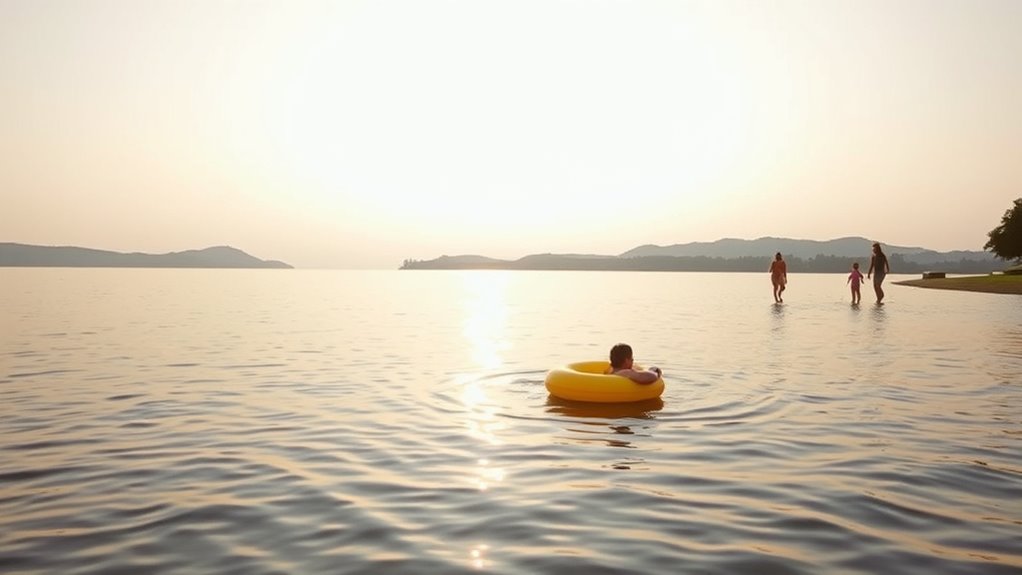The best times to swim and float safely are early mornings when water and air temperatures are cooler and crowds are smaller, creating a peaceful environment. Late afternoons around sunset offer calming views and slightly warmer conditions, perfect for relaxing. Avoid midday hours (10 a.m. to 4 p.m.) when the sun’s strongest rays increase the risk of sunburn and heat exhaustion. If you want to learn more about finding ideal swimming times, keep exploring these helpful tips.
Key Takeaways
- Swim late morning or early afternoon in warmer months for comfortable water temperatures.
- Avoid peak midday hours (10 a.m. to 4 p.m.) to minimize sunburn and heat exhaustion risks.
- Enjoy early mornings or late afternoons for peaceful, less crowded swimming and floating experiences.
- Check local water temperatures and weather conditions before swimming to ensure safety.
- Use sun protection and stay hydrated, especially during peak sunlight hours, to prevent sun-related health issues.

Swimming and floating are enjoyable activities that can boost your relaxation and well-being, but choosing the right time of day is essential for safety. One of the most important factors to contemplate is water temperature. During the warmer months, water tends to be more inviting in the late morning and early afternoon when the sun has had time to warm the surface. Swimming in water that’s too cold can lead to muscle cramps or hypothermia, especially if you stay in for an extended period. Conversely, during winter or cooler days, the water might be too cold in the morning, so waiting until mid-morning or early afternoon when the sun has warmed the water can make your swim more comfortable and safer. Always check local water temperature readings if possible, and listen to your body’s signals to avoid hypothermia or discomfort. Proper water temperature management is crucial for a safe swimming experience.
Sunlight exposure also plays a critical role in determining the best time to swim or float. During the middle of the day, typically between 10 a.m. and 4 p.m., the sun’s rays are the strongest. While sunlight can enhance mood and vitamin D absorption, it also increases the risk of sunburn and heat exhaustion. If you plan to swim during these hours, make sure to wear waterproof sunscreen, protective clothing, or a hat, and stay hydrated. On the other hand, early mornings and late afternoons tend to have gentler sunlight, which can be safer for sun-sensitive skin and reduce the risk of overheating. These times also offer a quieter, more peaceful environment, making your float or swim more relaxing.
Timing your activity also involves considering your personal schedule and environmental conditions. Early morning swims can be particularly invigorating, especially when the air and water are cooler but still manageable. This time often boasts less crowded conditions, allowing for a more peaceful experience. Evening swims, around sunset, can be equally calming, with the added benefit of cooler temperatures and softer sunlight. However, if you swim late in the day, ensure you have adequate lighting and are familiar with the area to prevent accidents once it gets dark. Always prioritize your safety, and never swim alone if you’re unsure about water conditions or visibility.
Frequently Asked Questions
How Does Water Temperature Vary Throughout the Day?
You’ll notice water temperature fluctuations throughout the day due to daily thermal patterns. In the morning, water tends to be cooler from overnight cooling, then warms up as the sun heats the surface. By midday, water reaches its warmest point, before cooling again in the evening as temperatures drop. This natural cycle means you might prefer swimming in the late morning or early afternoon when water is at its warmest.
Are There Specific Safety Concerns During Early Mornings?
They say “better safe than sorry,” and that’s especially true early mornings. During this time, you face hazards like lower visibility, colder water, and fewer lifeguards around. Always wear safety equipment like life jackets, keep a buddy nearby, and stay alert to avoid accidents. Early morning hazards can be tricky, but with proper precautions, you can enjoy a safe and invigorating swim.
How Does Sunlight Affect Underwater Visibility at Different Times?
Sunlight penetration varies throughout the day, affecting your underwater visibility. During midday, intense sunlight creates more underwater glare, making it harder to see clearly beneath the surface. In the early morning or late afternoon, sunlight is softer, reducing glare and improving visibility. Keep in mind that stronger sunlight can also cause reflections that obscure your view, so adjusting your position and swimming carefully can help you see better and stay safe underwater.
Can I Swim Safely After Heavy Rain or Storms?
Jumping into the water right after heavy rain isn’t worth the risk. Storm runoff can carry harmful pollutants and bacteria, making swimming unsafe. Plus, lightning risks are higher during and immediately after storms, so it’s best to wait until the skies clear completely. Even if it looks calm, dangerous currents and hidden debris can lurk beneath the surface. Play it safe—wait a good while before swimming after a storm.
Do Tides Influence the Best Swimming Times at Coastal Locations?
Yes, tides influence the best swimming times at coastal locations. You should pay attention to tidal patterns because high tides can increase surf conditions, making swimming riskier, while low tides might expose dangerous rocks or channels. By understanding these patterns, you can choose times when surf conditions are calmer and safer, ensuring a more enjoyable and secure swimming experience along the coast.
Conclusion
Choosing the best time to swim or float helps keep you safe and enjoy your time in the water. For example, swimming early in the morning or late afternoon reduces sun exposure and crowds, lowering risks. Imagine you’re relaxing during sunset, feeling calm and secure, knowing you’re avoiding peak sun hours and busy crowds. By planning your swim wisely, you can maximize safety and fun, making every dip a peaceful, enjoyable experience.










